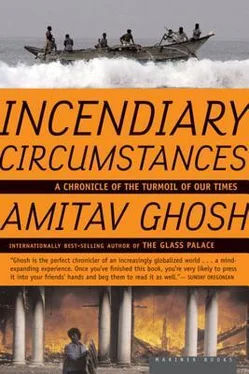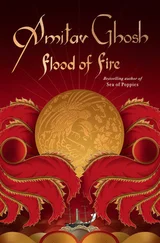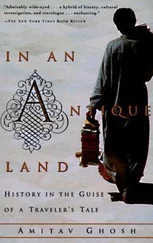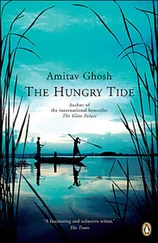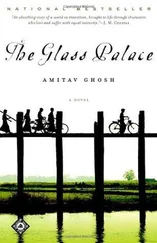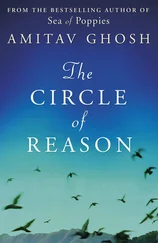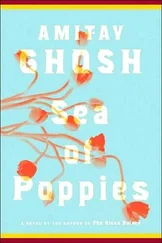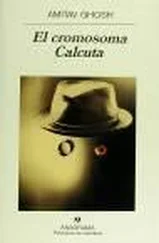While the performance was in progress, a correspondent spotted the most celebrated Parisian of all in the audience, the bearded, Mosaic figure of "the great Rodin…[going] into ecstasies over the little virgins of Phnom Penh, whose immaterial silhouettes he drew with infinite love."
Rodin, now, at the age of sixty-six, France's acknowledged apostle of the arts, fell immediately captive: in Princess Soumphady's young charges he discovered the infancy of Europe. "These Cambodians have shown us everything that antiquity could have contained," he wrote soon afterward. "It is impossible to think of anyone wearing human nature to such perfection; except them and the Greeks."
Two days after the performance Rodin presented himself at the dancers' Paris lodgings, at the Avenue Malakoff, with a sketchbook under his arm. The dancers were packing their belongings in preparation for their return to Marseille, but Rodin was admitted to the grounds of the mansion and given leave to do what he pleased. He executed several celebrated sketches that day, including a few of King Sisowath.
By the end of the day the artist was so smitten with the dancers that he accompanied them to the station, bought a ticket, and traveled to Marseille on the same train. He had packed neither clothes nor materials, and according to one account, upon arriving in Marseille he found that he was out of paper and had to buy brown paper bags from a grocery store.
Over the next few days, sketching feverishly in the gardens of the villa where the dancers were now lodged, Rodin seemed to lose thirty years. The effort involved in sketching his favorite models, three restless fourteen-year-olds called Sap, Soun, and Yem, appeared to rejuvenate the artist. A French official saw him placing a sheet of white paper on his knee one morning; he "said to the little Sap: 'Put your foot on this,' and then drew the outline of her foot with a pencil, saying 'Tomorrow you'll have your shoes, but now pose a little more for me!' Sap, having tired of atomizer bottles and cardboard cats, had asked her 'papa' for a pair of pumps. Every evening — ardent, happy, but exhausted — Rodin would return to his hotel with his hands full of sketches and collect his thoughts."
Photographs from the time show Rodin seated on a garden bench, sketching under the watchful eyes of the policemen who had been posted at the dancers' villa to ensure their safety. Rodin was oblivious: "The friezes of Angkor were coming to life before my very eyes. I loved these Cambodian girls so much that I didn't know how to express my gratitude for the royal honor they had shown me in dancing and posing for me. I went to the Nouvelles Galeries to buy a basket of toys for them, and these divine children who dance for the gods hardly knew how to repay me for the happiness I had given them. They even talked about taking me with them."
On their last day in France, hours before they boarded the ship that was to take them back to Cambodia, the dancers were taken to the celebrated photographer Baudouin. On the way, passing through a muddy alley, Princess Soumphady happened to step on a pat of cow dung. Horrified, she raised her arms to the heavens and flung herself, wailing, upon the dust, oblivious of her splendid costume. The rest of the troupe immediately followed suit: within moments the alley was full of prostrate Cambodian dancers, dressed in full performance regalia.
"What an emptiness they left for me!" wrote Rodin. "When they left… I thought they had taken away the beauty of the world… I followed them to Marseille; I would have followed them as far as Cairo."
His sentiments were exactly mirrored by King Sisowath. "I am deeply saddened to be leaving France," the king said on the eve of his departure. "In this beautiful country I shall leave behind a piece of my heart."
9
The trip to France evidently cast King Sisowath's mind into the same kind of turmoil, the same tumult, that has provoked generations of displaced students — the Gandhis, the Kenyattas, the Chou en Lais, among thousands of their less illustrious countrymen — to reflect upon the unfamiliar, wintry worlds beyond the doors of their rented lodgings.
On September 12, 1906, shortly after their return to Cambodia, the king and his ministers published their reflections in a short but poignant document. Cast in the guise of a royal proclamation, it was in fact a venture into a kind of travel writing. It began: "The visits that His Majesty made to the great cities of France, his rapid examination of the institutions of that country, the organization of the different services that are to be found there, astonished him and led him to think of France as a paradise." Emulation, they concluded, was "the only means of turning resolutely to the path of progress."
Over the brief space of a couple of thousand words the king and his ministers summed up their views on the lessons that France had to offer Cambodia. Most of these had to do with what later came to be called "development": communications had to be improved, new land cleared for agriculture; peasants had to increase their production, raise more animals, exploit their forests and fisheries more systematically, familiarize themselves with modern machinery, and so on. A generation later, Cambodian political luminaries such as Khieu Samphan, writing their theses in Paris, were to arrive at oddly similar conclusions, although by an entirely different route.
But it was on the subject of the ideal relationship between the state and its people that the king and his ministers were at their most prescient. It was here, they thought, that Europe's most important lessons lay. "None should hesitate to sacrifice his life," they wrote, "when it is a matter of the divinity of the king or of the country. The obligation to serve the country should be accepted without a murmur by the inhabitants of the kingdom; it is glorious to defend one's country. Are Europeans not constrained by the same obligation, without distinction either of rank or of family?"
Alas for poor King Sisowath, he was soon to learn that travel writing was an expensive indulgence for those who fell on his side of the colonial divide. In 1910 the Colonial Ministry in Paris wrote asking the king to reimburse the French government for certain expenses incurred during his trip to France. As it happened, Cambodia's budget had paid for the entire trip, including the dancers' performance at the Bois du Boulogne. In addition, the king, who was ruinously generous by nature, had personally handed out tips and gifts worth several thousands of francs. In return he and his entourage had received a few presents from French officials. Among these were a set of uniforms given by the minister of colonies and some rosebushes that had been presented to the king personally at the Elysée Palace by none other than the president of the republic, Armand Fallières. The French government now wanted to reclaim the price of the uniforms and the rosebushes from the Cambodians.
For once the obsequious Minister Thiounn took the king's side. He wrote back indignantly, refusing to pay for gifts that had been accepted in good faith.
The royal voyage to France found its most celebrated memorial in Rodin's sketches. The sketches were received with acclaim when they went on exhibition in 1907. After seeing them, the German poet Rilke wrote to the master to say, "For me, these sketches were among the most profound of revelations."
The revelation Rilke had in mind was of "the mystery of Cambodian dance." But it was probably the sculptor rather than the poet who sensed the real revelation of the encounter: the power of Cambodia's involvement in the culture and politics of modernism, in all its promise and horror.
10
As for King Sisowath, the most significant thing he ever did was to authorize the founding of a high school where Cambodians could be educated on the French pattern. Known initially as the Collège du Protectorat, the school was renamed the Lycée Sisowath some years after the king's death.
Читать дальше
